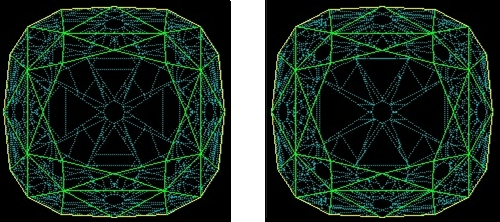
Specifications
Weight: 140.64 carats
Dimensions: 30.50 x 28.90 x 20.30 mm
Color: Colorless
Weight of Rough: 410 carats
Origin: Paritala-Kollur Mine, India
Date Found: 1698
Current Location: Louvre, Paris
Details
The Regent has been reported as one of the most perfectly cut diamonds since its cutting around 1710, a title it could probably hold even today. What a tribute to the cutter!
There were differing reports as to the pavilion main culet angles ranging from 41 3/4° (Tillander, 1966) to 45° (Morel, 1988; Bari, 2001). This needed to be resolved before the stone could be cut.
Since the diamond is on display in the Louvre, it is not accessible to resolve this issue with any finality. Leads casts of the rough, and at some of the steps of the cutting process, are at the Natural History Museum in London. Unfortunately, there is no lead cast of the finished stone.
Fortunately, pavilion main angles can be determined by the reflections of the culet facet within the crown facets. Through a study of historical diamond cutting techniques, I discovered that the placement of the reflection of the culet facet is directly related to the pavilion main angles. In the left picture (below), the mains are 41 3/4°, in the right 45°. Notice in the latter how the culet facet reflection moved closer to the girdle. Now all one has to do is compare the modeling reflection to that in the reference photograph, and change the former until it matches the latter. Resolution is accurate to about 0.5°, and sometimes lower depending on ones tenacity. Kind of a handy phenomenon to understand when trying to recreate an accurate replica when given conflicting information.

Another nice thing about this phenomenon is that it helps to correct for parallax. Some stones are cut slightly asymmetric, others are perfectly symmetrical. Photographs are the best record for recreating a stone, far better than a line drawing with the inherent errors of artistic skill, license, and accuracy. As good as photographers are, the camera is rarely orthogonal to the table of the stone. Instead, it is usually tilted a few degrees away. This makes a symmetrical stone look asymmetrical, and also changes the facet pattern, angles, and outline shape. Fortunately, the placement of this reflection can be used to correct for parallax, giving even more accuracy to the information derived from the photograph.
And yes, these are some of my secrets, but this site is for education, not commercialization, so enjoy.
Also, do your own research, but the dimensions of the Regent are all different as reported by the Louvre, Balfour (2009), Tillander (1966), Morel (1988), Bari (2001), and on the web. The replica here used the dimensions from the Louvre. Which one would you use?
